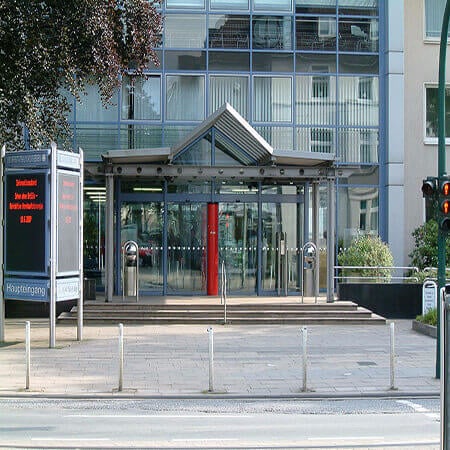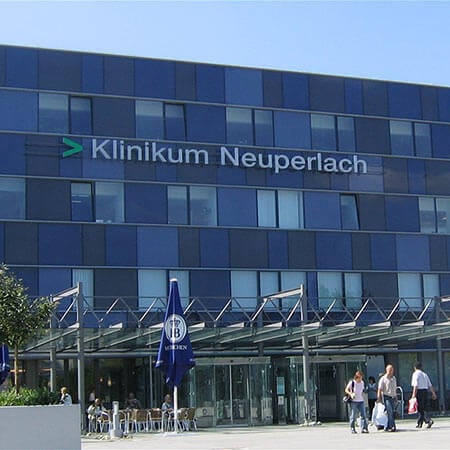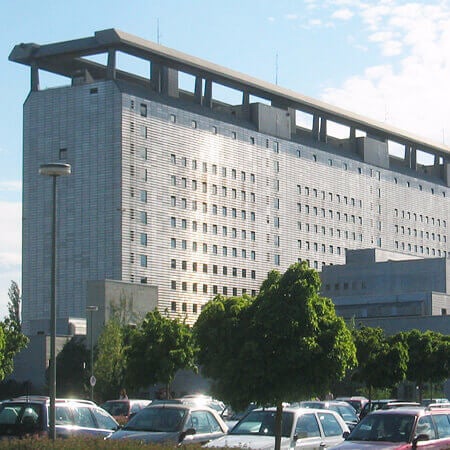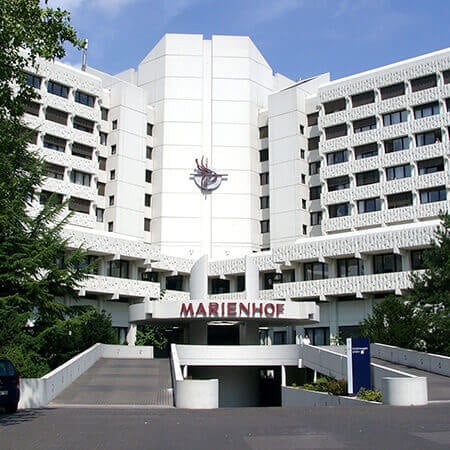Angina (cardiac angina)
Due to the difficulties associated with the organization of treatment in Turkey, Switzerland, South Korea and India, we are not currently processing requests to these regions.
If you are interested in treatment in Germany, please leave a request and our specialists will contact you as soon as possible.
Cardiac angina is the clinical form of ischemic heart disease which is manifested by pressing pain behind the sternum. The disease affects 15% of males and 5% of women. It can lead to the development of myocardial infarction if lasting for more than two years. Cardiac angina is diagnosed mostly among elderly people. It is observed only among 0.5% of women and 3.5% of men under the age of 55. After 65 years old it is observed among 15% of women and 20% men.
The Booking Health portal presents 79 German clinics specializing in angina (cardiac angina, breast pang, stenocardia) treatment
Show all clinics
Cardiac angina – Diagnostics
Depending on the time of the first pain attack and the dynamics of the syndrome, the following forms of cardiac angina are distinguished:
First time emerged angina pectoris. This diagnosis is made when the chest pain disturbed the patient for the first time no more than 1 month ago. Newly diagnosed angina may have different clinical course. Myocardial infarction is possible in the most unfavorable case. The favourable prognosis presupposes the regress of symptoms.
Stable angina is diagnosed when a month has passed and the attacks are repeated. Stable angina is characterized by the occurrence of pain under the influence of factors that increase myocardial oxygen demand, and the spontaneous disappearing of symptoms in 1-2 minutes after stopping physical activity.
Stable angina is divided into four functional classes:
- An attack occurs only after intense or prolonged physical activity
- Attack occurs when walking distance of 500 m on level ground, or when climbing the stairs to the 1st floor
- For the emergence of an attack it is enough to walk 100 m on level ground
- Minimal physical activity causes attacks, they can also appear at rest or during the sleep
Progressive angina. The diagnosis is made if there is a sudden increase in attacks frequency, decrease in the threshold of physical activity tolerance, an increase in the duration of pain and its intensity. In this case the risk of heart attack increases significantly.
Spontaneous angina occurs without any physical activity. It is caused by a spasm of the coronary arteries. Attacks are usually longer (approximate duration is 10-30 minutes) and there are 2-5 attacks in a row. An impaired heart rate is observed in 50% of patients during an attack.
Instrumental diagnostics methods:
- ECG under physical load. It allows the doctor to identify myocardial hypoxia. There are no changes in the ECG at rest in 50% of patients.
- Holter monitoring. ECG is recorded continuously during a day. At that time, the patient lives his usual life.
- Stress echocardiography. Heart ultrasound is performed after the exercise (bicycle ergometry or treadmill test) and areas of myocardial contractility violations are identified.
- Coronary angiography allows doctor to assess the degree of coronary artery damage. During the procedure, contrast medium is injected into the vessels, then an X-ray is performed.
Best clinics for the angina (cardiac angina) diagnostics in Germany:
Cardiac angina – Treatment
Cardiac angina is treated with the conservative therapy. Its main purposes are to improve the patient’s life and prevent further atherosclerotic artery damage, as well as reduce the risk of myocardial infarction.
Surgery is performed in cases of:
- Significant deterioration in the patient's quality of life, which is observed during stable angina of the 3-4 functional class
- Detected with angiography stenosis of the left main coronary artery (more than 50% of the lumen is closed)
- The inefficiency of the conservative therapy, when the phenomenons of myocardial ischemia are not eliminated by administering drugs
The purpose of surgical treatment methods is to restore normal blood supply to the myocardium. Various operations are performed, the choice depends on the clinical situation.
- Vascular stenting. Stent is implanted inside the affected coronary artery (a spiral lattice metal tube) which mechanically affects the vessel, extending it and providing normal blood flow.
- Coronary artery bypass surgery is indicated in case of multiple damages of coronary arteries and their branches. Blood flow is restored by passing the affected vessels. For this purpose, the grafts from the patient's own veins and arteries (internal thoracic, radial artery, great saphenous vein of the lower limbs) are used.
- Laser revascularization is a minimally invasive surgery, which is performed with endoscopic access. The multiple holes are made in the myocardium. As a result of the operation, blood begins to flow into the tissues of the muscle layer of the heart from the left ventricle, providing its trophic (supply).
- Atherectomy is only possible if the artery is occluded in one small area. Removal of a blood clot (burning out) is performed with the help of surgical instrument called the excimer laser.
- Stem cells therapy is performed after myocardial revascularization to restore its structure. Stem cells are taken from the patient’s body. About 10 thousand of them are selected and cultured. As a result, more than 200 million of cells are produced. Part of this population becomes cardiomyoblasts (heart cells). They are injected into the human body and reach the myocard via the bloodstream. These cells take the place of those that have been damaged as a result of ischemic heart disease.
Best clinics for the angina (cardiac angina) treatment in Germany:

University Hospital Essen
9061.02
28918.2326265.23


University Hospital of Ludwig Maximilian University of Munich
Cardiac angina – Rehabilitation
Cardiological rehabilitation improves the quality of life in patients with cardiovascular diseases. It increases the effectiveness of maintenance treatment in the case of chronic cardiovascular diseases, and also facilitates recovery after exacerbations. Rehabilitation is extremely important in case of cardiac surgical interventions.
Cardiological rehabilitation has the following aims:
- Restoration of heart muscle normal function
- Elimination of symptoms (for example, chest pain, dyspnea, etc.)
- Improving working capacity and providing patient with the opportunity to return to previous professional activities
- Improving physical stamina
- Prevention of exacerbations (including elimination of the risk factors)
- Consulting the patient on self-control and basic principles of self-help
- Improving patient's mental state, ability to "live with the disease"
Effective cardiological rehabilitation is performed only in countries with the developed medicine, as innovative medications, appropriate medical equipment and qualified healthcare professionals are available only there. Basic methods of cardiological rehabilitation include:
- Drug support for normalization of blood pressure, blood clotting, cholesterol level
- Dosed physical exercises under the supervision of an instructor, with a gradual increase in intensity
- Physiotherapy (darsonvalization, electrophoresis with medications, electrosleep, laser and magnetotherapy)
- Relaxing techniques (massage, aromatherapy, acupuncture, psychotherapy)
- Dietotherapy (control of salt and liquid amount, using spices, etc.)
- Modification of lifestyle (smoking cessation, body weight normalization)
In Germany, cardiological rehabilitation undergoes under the constant control of cardiologists, therapists and rehabilitation specialists. Programs are designed for 2 weeks. If necessary, they can last much longer. In this country, the patient is provided with qualitative care, accommodation in comfortable rooms and individually selected meals.
Rehabilitation programs in Germany show one of the best results in the world. Most patients successfully restore their working capacity and excellent health there. They remain physically active, return to the full social and family life.
Best clinics for cardiac rehabilitation in Germany:
Author:
The article was edited by medical expert, board certified Dr. Nadezhda Ivanisova. For the treatment of the conditions referred to in the article you must consult a doctor; the information in the article is not intended for self-medication!
Source:
ECR - European Cardiology Review
American College of Cardiology
The cost of services includes
Here you can find the cost of treatment for this disease at the German University Hospitals. Leave a request and we will provide a free consultation with a doctor and will start organizing the whole treatment process.
The program includes the following:
- Issuing of an invitation for getting a visa for treatment as quick as possible
- Fixing an appointment at a time convenient for you
- Preliminary organization of a comprehensive examination and discussion of the forthcoming treatment plan
- Arranging transfer from the airport to the hospital and back to the airport
- Provision of interpreting services and services of a personal medical coordinator
- If necessary, assistance in the organization of further surgical treatment
- Provision of a medical insurance against treatment complications covering up to 200,000 euro
- Preparation and translation of medical records and recommendations from the hospital
- Assistance in the subsequent communication with your attending physician, including consultations on repeated X-ray images through the unique medical document management system E-doc




